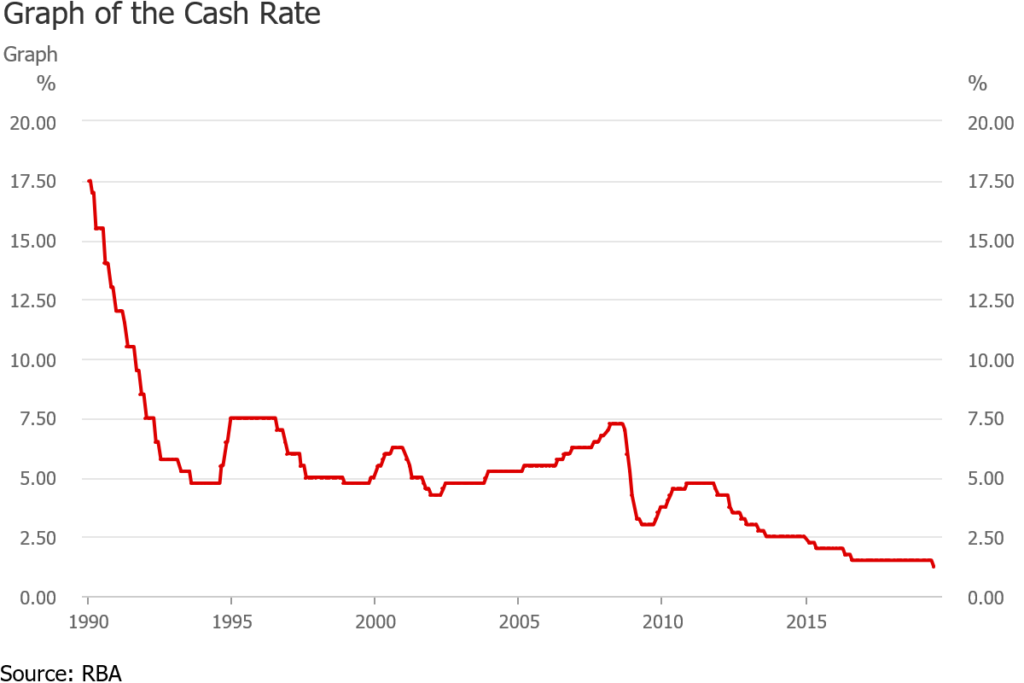In early 2009 in the depths of the financial crisis, I cut out a small section of the Australian Financial Review and stuck it on my wall. That piece of paper contained a list of short and long term interest rates. I thought at the time that we would never again in my lifetime see an interest rate so low. How wrong I was!
Fast forward to January 2019. Variable mortgage interest rates are around 4% and if you can get 2% on your term deposit you’re doing very well. And you’ve probably got to lock your money away for a year to do it. Interest rates, both short and long term, are well below those reached in 2009, as can be seen from the RBA graph below.

Seeing interest rates this low without a major economic meltdown seems a little strange. But in the last month, it’s gone even further. Australian 10 year bond rates (essentially what our Government pays for 10 year debt) have hit all time lows of around 1.4%. The reason for this is hugely important and the implications even more so. Our Reserve Bank of Australia has finally capitulated to the global trend, and relentless pressure, and abandoned their previous stance of holding interest rates steady.
What happened
At their last meeting on 4 June, the RBA cut the interest rate by 0.25%, reducing the cash rate to 1.25%. But the real issue is not just the rate cut, but their reasoning for doing so. Previously, the RBA seemed to take the view that it was prudent not to lower rates, unless our economy was in trouble, or was likely to be in trouble soon. Under previous Governor Glenn Stevens, and initially, under current Governor Philip Lowe, the RBA believed that it was prudent to keep some interest rate ammunition aside in the case of a real financial emergency. Just before that last meeting, the RBA changed tack. They focused much more on growth in wages than inflation. And they seem to have formed the view that if wages are not growing at well above average, they can and should continue to cut interest rates.
The Australian economy certainly doesn’t appear to be in any imminent danger. It’s going OK, but not great. That has been the case for at least the past 2 years, and yet the RBA has suddenly decided to cut rates now. They have succumbed to the global trend of cutting rates not because the economy is going badly, but because it is not going as well as it could be. Not only that, but there is also a lot of talk about the potential for the RBA to adopt other tactics designed to keep interest rates low, known as quantitative easing.
Australia is arriving late to the global interest rate party, but make no mistake, we are here. We have now decided that average is not good enough, and the RBA will act to stimulate the economy for as long as it is not performing above average. In the long term, that may well be a very dangerous thing to do.
The impact of this change
Very low interest rates lead to asset bubbles. We have been saying for some time that Australian stocks on average are slightly overvalued. But that level of excess is nowhere near as high as many other global markets, including the US and NZ. Unless we see higher than average wage growth in Australia, or a major correction in global markets, that may well be about to change.
The impact of lower interest rates in a relatively healthy economy could be wide ranging. Valuations for growth stocks were already sky high, so they might benefit less from this new round of stimulus. We’ve already seen big increases in share prices in the last month for banks (helped along by the Coalition election win) and many other large stocks. As time goes on, we could see mid and smaller companies and out of favour value companies get bid up to much higher prices as well. We will also see a lot of takeover activity and companies will borrow to buy back their stock, pay special dividends and to invest. All this means the Australian stock market plays catch-up to global markets.
We are also likely to see a residential property revival. There are early signs that values in Sydney and Melbourne have bottomed. We expect renewed interest to lead to higher prices. You can now get 3-5 year fixed rate mortgages below 4%. We could even be entering the age of positively geared property!
Summing up
While lower interest rates may be fantastic for short term returns, unfortunately, it’s not necessarily being driven by real growth. In this case, all we’ll really be doing is capturing future returns ahead of time by paying more today.
Take care and all the best with your investing.
We hope that was helpful. If so, here are some other resources you might like.
Find out more about the Affluence Investment Fund.
See more of our articles.
Find out all about us.
Subscribe to our free monthly Affluence newsletter.
Become anAffluence Memberand access profiles of some of Australia’s best fund managers and full details of our Affluence investment portfolios.







